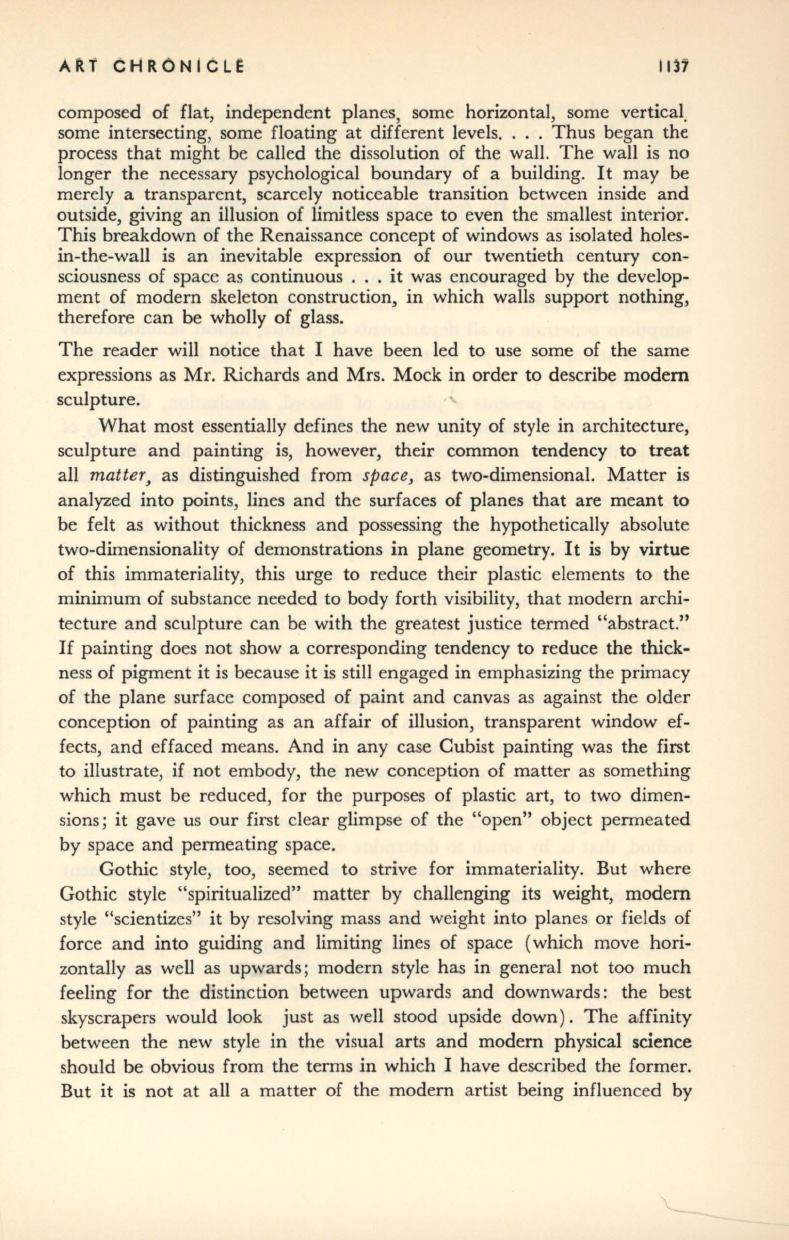
AU CHRONIcLE
1131
composed of flat, independent planes, some horizontal, some vertical.
some intersecting, some floating at different levels.... Thus began the
process that might be called the dissolution of the wall. The wall is no
longer the necessary psychological boundary of a building. It may be
merely a transparent, scarcely noticeable transition between inside and
outside, giving an illusion of limitless space to even the smallest interior.
This breakdown of the Renaissance concept of windows as isolated holes–
in-the-wall is an inevitable expression of our twentieth century con–
sciousness of space as continuous ... it was encouraged by the develop–
ment of modern skeleton construction, in which walls support nothing,
therefore can be wholly of glass.
The reader will notice that I have been led to use some of the same
expressions as Mr. Richards and Mrs. Mock in order to describe modem
sculpture.
What most essentially defines the new unity of style in architecture,
sculpture and painting is, however, their common tendency to treat
all
matter,
as distinguished from
space,
as two-dimensional. Matter is
analyzed into points, lines and the surfaces of planes that are meant to
be felt as without thickness and possessing the hypothetically absolute
two-dimensionality of demonstrations in plane geometry.
It
is by virtue
of this immateriality, this urge to reduce their plastic elements to the
minimum of substance needed to body forth visibility, that modern archi–
tecture and sculpture can be with the greatest justice termed "abstract."
If
painting does not show a corresponding tendency to reduce the thick–
ness of pigment it is because it is still engaged in emphasizing the primacy
of the plane surface composed of paint and canvas as against the older
conception of painting as an affair of illusion, transparent window ef–
fects, and effaced means. And in any case Cubist painting was the first
to illustrate, if not embody, the new conception of matter as something
which must be reduced, for the purposes of plastic art, to two dimen–
sions; it gave us our first clear glimpse of the "open" object permeated
by space and permeating space.
Gothic style, too, seemed to strive for immateriality. But where
Gothic style "spiritualized" matter by challenging its weight, modem
style "scientizes" it by resolving mass and weight into planes or fields of
force and into guiding and limiting lines of space (which move hori–
zontally as well as upwards; modern style has in general not too much
feeling for the distinction between upwards and downwards: the best
skyscrapers would look just as well stood upside down). The affinity
between the new style in the visual arts and modern physical science
should be obvious from the terms in which I have described the former.
But it is not at all a matter of the modern artist being influenced by


